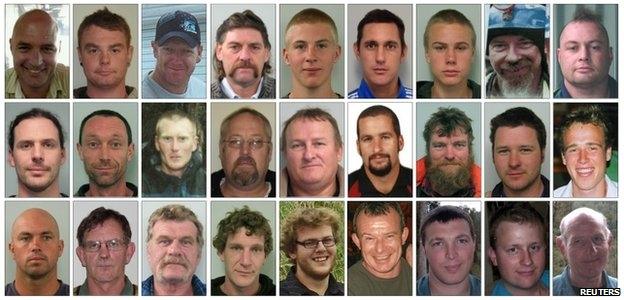New Zealand traumatised by Pike River mine disaster
- Published

The operator of the mine said it would make every effort to retrieve the men's bodies. Francis Skiddy Marden and Stuart Gilbert Mudge are not pictured
New Zealand has begun to mourn 29 miners who were declared dead earlier after a second explosion ripped through the shaft where they were trapped.
A memorial service was held in the town of Greymouth, and Prime Minister John Key said it was a "national tragedy".
Some devastated relatives said the men, trapped since last Friday, could have been saved if rescuers had been faster.
Queen Elizabeth, who is New Zealand's head of state, said she was deeply saddened by the disaster.
"I send my thanks and deep appreciation to everyone who has worked so hard to attempt a rescue, and also to those who will have a part to play in the task of healing the pain that is being felt throughout New Zealand and around the world," she said.
Relatives' anger
Rescuers did not manage to make contact with the miners - who included 24 New Zealanders, two Australians, two Britons and a South African.
New Zealand Prime Minister John Key: ''We are a nation in mourning''
Some grieving relatives accused the authorities of being too cautious in the efforts to save the men, trapped last Friday after an explosion in the Pike River mine.
Laurie Drew, whose 21-year-old son Zen was among those killed, said the miners' families were angry that rescuers had not entered the mine after the first blast.
"They had their window of opportunity that Friday night, and now the truth can't come out because no-one alive will be able to come out and tell the truth about what went on down there," he said.
But mining rescue expert Andrew Watson told the BBC that the emergency crews would have been totally focused on trying to rescue their colleagues.
"There is absolutely no doubt that if it had been possible for them to enter the mine at any time, they would have done so," he said.
Officials believed the poisonous and combustible atmosphere deep underground had made a swift rescue attempt impossible.
Air samples taken from inside the mine through a 162m (530ft) bore-hole completed on Wednesday had shown dangerous levels of methane and carbon monoxide.
Police confirmed a second explosion had ripped through the mine at 1437 (0137 GMT) on Wednesday, ending hopes of a rescue.
Grey District mayor Tony Kokshoorn said family members wept, shouted and fell to the floor after hearing the news.
"This has got to be the darkest day for me, for Greymouth, for everywhere. Things are never going to be the same," he said.
"It's unbelievable. This is the West Coast's darkest hour. It doesn't get worse than this."
Mr Key, who declared that New Zealand was a "nation in mourning", said he would travel to the area on Thursday to meet the miners' families and thank the rescue crews.
Prince Charles: "Our hearts go out to them"
"New Zealand is a small country, a country where we are our brother's keeper, so to lose this many brothers at once strikes an agonising blow," he told a news conference in Wellington.
"The 29 men whose names and faces we have all come to know will never walk amongst us again. We are a nation in mourning."
He also offered his condolences to Australia, South Africa and the UK.
Mr Key praised all those involved in the rescue attempt, and said there would now be a full inquiry into how the tragedy had happened, with the aim of making sure it was not repeated.
Analysts say New Zealand's mines have a good safety record, and this was the worst disaster for almost a century.
Pike River is not far from the Strongman mine, where an underground explosion killed 19 men in January 1967.
New Zealand's worst mining disaster was in 1896, when a gas explosion at the Brunner mine, also near Greymouth, left 65 miners dead. It accessed the same coal seam as the Pike River mine.

- Published24 November 2010
- Published24 November 2010
- Published24 November 2010
- Published24 November 2010
- Published14 October 2010
- Published22 November 2010